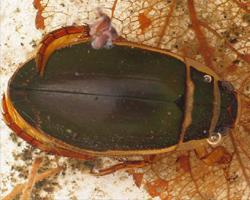
Poids et mesures
| Longueur | de 27 à 35 mm |
|---|
Statut de conservation
| Menacé |
Description de l'animal
The Great Diving Beetle (Dytiscus marginalis) is a fascinating and formidable predator in freshwater habitats across Europe and Northern Asia. This species belongs to the family Dytiscidae, which comprises the diving beetles, known for their aquatic lifestyle and remarkable diving abilities. The Great Diving Beetle is a prominent member of this family, showcasing unique adaptations that make it a successful hunter and an intriguing subject of study in the world of entomology.Physically, the Great Diving Beetle presents a robust and streamlined body, measuring up to 35mm in length for females, which are slightly larger than males. The sexual dimorphism extends to the texture of the elytra (the hardened forewings that cover the flying wings), with females having smoother elytra compared to the grooved ones of males, aiding in their identification. Their coloration is predominantly dark, with a greenish or olive hue, and is complemented by a distinctive yellow border running along the sides of the elytra and thorax, giving them their common name.
One of the most remarkable aspects of the Great Diving Beetle is its adaptations for an aquatic life. The beetle is equipped with large, flattened hind legs covered with hairs, functioning as efficient oars for swimming. These powerful limbs, along with a streamlined body, allow it to move swiftly through water, making it an adept hunter. The beetle is capable of diving by storing air under its elytra, which acts like a natural scuba tank, enabling it to stay submerged for extended periods as it searches for prey or avoids predators.
The diet of the Great Diving Beetle is varied and includes a wide range of aquatic organisms. Larvae, known as water tigers due to their aggressive nature, are particularly voracious and will attack almost anything they can overpower, including fish, tadpoles, and other invertebrates. Adults, while still predatory, tend to have a more varied diet that can include plants and algae, making them omnivorous to some extent.
Reproduction in the Great Diving Beetle involves a series of intricate behaviors. Males use their specially adapted front legs, which are equipped with suction cups, to grasp onto the slippery surface of the female's body during mating. After mating, the female lays her eggs on vegetation just below the water surface, ensuring the next generation's safety and access to food upon hatching.
The life cycle of the Great Diving Beetle is a testament to its adaptability and resilience. From egg to larva, then pupa, and finally to adulthood, each stage presents its own set of challenges and adaptations. The larval stage, in particular, is a critical period where the "water tigers" must feed voraciously to accumulate enough energy for the pupal stage and eventual metamorphosis into adults.
In conclusion, the Great Diving Beetle (Dytiscus marginalis) is a remarkable creature, showcasing a plethora of adaptations that enable it to thrive in aquatic environments. Its life cycle, from a voracious larva to a powerful adult, illustrates the complexity and efficiency of nature's designs. As a top predator in its habitat, the Great Diving Beetle plays a crucial role in maintaining the ecological balance, controlling the populations of other aquatic organisms, and contributing to the biodiversity of freshwater ecosystems.
Nouvelles photos d'animaux
Top 10 des animaux
- Dolphin gull (Leucophaeus scoresbii)
- Japanese macaque (Macaca fuscata)
- Greek tortoise (Testudo graeca)
- Stone loach (Barbatula barbatula)
- Galápagos tortoise (Geochelone nigra complex)
- Russian tortoise (Testudo horsfieldii)
- Diana monkey (Cercopithecus diana)
- Moustached guenon (Cercopithecus cephus)
- Common flying dragon (Draco volans)
- Galápagos penguin (Spheniscus mendiculus)